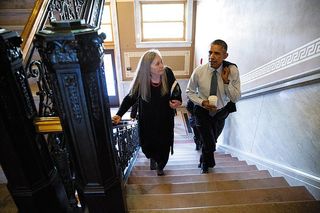
Barack Obama interviews Marilynne Robinson in The New York Review of Books:
The President: Well, now there’s been that strain in our democracy and in American politics for a long time. And it pops up every so often. I think the argument right now would be that because people are feeling the stresses of globalization and rapid change, and we went through one of the worst financial crises since the Great Depression, and the political system seems gridlocked, that people may be particularly receptive to that brand of politics.
Robinson: But having looked at one another with optimism and tried to facilitate education and all these other things—which we’ve done more than most countries have done, given all our faults—that’s what made it a viable democracy. And I think that we have created this incredibly inappropriate sort of in-group mentality when we really are from every end of the earth, just dealing with each other in good faith. And that’s just a terrible darkening of the national outlook, I think.
The President: We’ve talked about this, though. I’m always trying to push a little more optimism. Sometimes you get—I think you get discouraged by it, and I tell you, well, we go through these moments.
Robinson: But when you say that to me, I say to you, you’re a better person than I am.
The President: Well, but I want to pick up on the point you made about us coming from everywhere. You’re a novelist but you’re also—can I call you a theologian? Does that sound, like, too stuffy? You care a lot about Christian thought.
Robinson: I do, indeed.
The President: And that’s part of the foundation of your writings, fiction and nonfiction. And one of the points that you’ve made in one of your most recent essays is that there was a time in which at least reformed Christianity in Europe was very much “the other.” And part of our system of government was based on us rejecting an exclusive, inclusive—or an exclusive and tightly controlled sense of who is part of the community and who is not, in favor of a more expansive one.
Tell me a little bit about how your interest in Christianity converges with your concerns about democracy.
Robinson: Well, I believe that people are images of God. There’s no alternative that is theologically respectable to treating people in terms of that understanding. What can I say? It seems to me as if democracy is the logical, the inevitable consequence of this kind of religious humanism at its highest level. And it [applies] to everyone. It’s the human image. It’s not any loyalty or tradition or anything else; it’s being human that enlists the respect, the love of God being implied in it.
More here.
As far as debuts went, there was nothing quite like it. A 250-page novel, with a three-sentence premise: “Darashikoh Shezad is an ex-banker, pot-smoker, and downwardly mobile heroin addict who also happens to have fallen for his best friend’s wife. He is on trial. You are to be his judge.”
